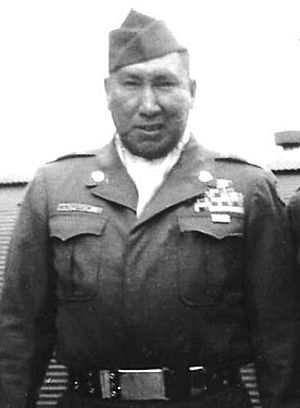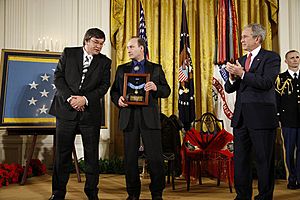Woodrow W. Keeble facts for kids
Quick facts for kids
Woodrow W. Keeble
|
|
|---|---|

MSG Woodrow W. Keeble, Medal of Honor recipient
|
|
| Born | May 16, 1917 Waubay, South Dakota |
| Died | January 28, 1982 (aged 64) Sisseton, South Dakota |
| Place of burial |
Sisseton Cemetery, Sisseton, South Dakota
|
| Allegiance | United States of America |
| Service/ |
United States Army |
| Years of service | 1941–1946, 1951-1952 |
| Rank | Master Sergeant |
| Unit | Company I, 164th Infantry Regiment 1st Platoon, George Company, 2nd Battalion, 19th Infantry Regiment |
| Battles/wars | World War II Korean War |
| Awards | |
Woodrow Wilson Keeble (May 16, 1917 – January 28, 1982) was a brave soldier from the Sisseton Wahpeton Oyate tribe. He served in the U.S. Army during both World War II and the Korean War. In 2008, many years after he passed away, he received the Medal of Honor. This is the highest award for bravery a soldier can get in the United States.
Woodrow Keeble was a full-blooded member of the Dakota people from the Lake Traverse Indian Reservation. On March 3, 2008, President George W. Bush gave him the Medal of Honor. This happened after his family and politicians from North Dakota and South Dakota worked hard for many years. Keeble had already received the Distinguished Service Cross in 1952 for the same brave actions in the Korean War. He was wounded five times in total during both wars and received four Purple Hearts.
Contents
Woodrow Keeble's Early Life
Woodrow Keeble was born on May 16, 1917, in Waubay, South Dakota. His parents were Isaac and Nancy Keeble, both from the Sisseton Wahpeton Oyate tribe. When he was very young, his family moved to Wahpeton, North Dakota. His mother worked at the Wahpeton Indian School, which is now called Circle of Nations School.
Woodrow's mother died when he was a child. His father enrolled Woodrow and his brothers and sisters in the school permanently. Woodrow was very good at sports, especially baseball. He was a great pitcher for the Wahpeton amateur team. He was even being considered by the Chicago White Sox, a professional baseball team. But then, his Army National Guard unit was called to serve in World War II on February 10, 1941.
Serving in World War II
During World War II, Keeble was part of the famous 164th Infantry Regiment from North Dakota. After training, his unit went to Australia. They were preparing for battles in the Pacific Ocean. Keeble's unit was part of the Americal Division.
On October 13, 1942, the 164th Infantry landed on Guadalcanal. They were there to help the First Marine Division, who had fought hard against the Japanese. Keeble's regiment was the first U.S. Army unit to attack the enemy in the Pacific.
The battles on Guadalcanal were very tough. Japanese soldiers often charged wildly, leading to hand-to-hand combat that sometimes lasted all night. During these intense battles, Woodrow Keeble became known for his bravery and skill. He was taller than most soldiers and was an expert with the Browning Automatic Rifle. He was also great at throwing hand grenades with amazing accuracy, like a baseball pitcher.
A soldier who fought with him said, "The safest place to be was right next to Woody." The Americal Division fought very well on Guadalcanal. The 164th Infantry played a key role in defeating a major Japanese attack. Their bravery earned them a special award called the Navy Presidential Unit Citation.
After Guadalcanal, Keeble and his regiment fought on other islands like Bougainville, Leyte, Cebu, and Mindanao. After Japan surrendered, his division helped with the occupation of Yokohama. Keeble left the Army on April 11, 1946, after more than five years of service. He had spent most of that time overseas.
After the war, Keeble went back to Wahpeton and worked at the Wahpeton Indian School. In 1947, he married Nettie Abigail Owen-Robertson.
Woodrow Keeble's Thoughts on Combat
Woodrow Keeble once shared his feelings about being in battle. He said that before he experienced war, he might have called someone a "coward" for showing fear. But after seeing the horrors of combat, he understood that fear is a very powerful feeling.
He wrote that fear can make people lose their reason. But even when he felt intense fear, he never left his position or avoided dangerous duties. He said, "Fear did not make a coward out of me."
Serving in the Korean War
The 164th Infantry Regiment was called back to duty on January 16, 1951, during the Korean War. When his officer needed to choose sergeants for the front lines, Keeble volunteered. He said, "Somebody has to teach these kids how to fight."
Keeble joined George Company, 2nd Battalion, 19th Infantry Regiment. Because of his experience and leadership, he quickly became a master sergeant, leading the 1st Platoon. The fighting in 1951 was very deadly. On October 13, 1951, Keeble's division was ordered to capture a series of mountains. These mountains protected a major Chinese supply base.
Woodrow Keeble was known as a gentle giant by his friends, but he was a fierce fighter. Official records show he was wounded on October 15, 17, 18, and 20. For his bravery on October 18, he received a Silver Star. His actions on October 20 made him a legend.
George Company had been fighting for six days straight. They faced Chinese soldiers dug deep into Hill 675–770. This was the last major Chinese stronghold. Keeble had already been shot twice in his arm, had grenade shrapnel in his face, and a twisted knee. Doctors had even removed 83 pieces of shrapnel from him. But Keeble refused to stay back.
Keeble led his platoons in three attacks on the hill, but they were all pushed back. The Chinese had machine guns in strong bunkers called "pillboxes." After the third attack, Keeble decided to try a solo assault. He told a relative he would either succeed or die trying.
Armed with grenades and his Browning Automatic Rifle, Keeble crawled close to the enemy. He attacked the left pillbox with grenades and rifle fire, destroying it. Then he moved to the other side and took out the right pillbox. Finally, he threw a grenade into the back of the middle pillbox, destroying it too.
An eyewitness said that the enemy threw so many grenades at Keeble that it looked like a flock of blackbirds. But Keeble kept going. Only after he destroyed the machine guns did he order his men to advance and take the hill. That day, Master Sergeant Keeble single-handedly destroyed three enemy machine-gun bunkers and killed seven other enemy soldiers.
His bravery was so amazing that he was recommended for the Medal of Honor twice. But both times, the recommendations were lost. He received the Distinguished Service Cross instead. Years later, in 2008, this award was upgraded to the Medal of Honor. Keeble left the front lines to recover from his wounds and was discharged on August 26, 1952.
Later Life and Health
After the Korean War, Keeble returned to North Dakota and worked at the Wahpeton Indian School again. He then became very ill with tuberculosis and needed long-term treatment. He had surgery to remove one of his lungs. He also suffered several strokes, which made it hard for him to speak or move.
His first wife, Nettie, passed away, and Keeble raised their young son, Earl, alone. Despite his health problems, Keeble kept going. In 1967, he married Blossom Iris Crawford-Hawkins, who was the first Sioux woman to earn a Doctorate of Education. Keeble was a member of the Veterans of Foreign Wars (VFW).
Woodrow Keeble died on January 28, 1982. He is buried in Sisseton, South Dakota. In 2008, his tombstone was replaced with a special Medal of Honor headstone.
Campaign for the Medal of Honor
Woodrow Keeble's family and friends never gave up trying to get him the Medal of Honor. Senators from North and South Dakota, including Byron Dorgan, Kent Conrad, John Thune, and Tim Johnson, strongly supported this effort.
In 2006, the Secretary of the Army recommended that Keeble's Distinguished Service Cross be upgraded. However, a rule about how long after an event an award could be given seemed to stop it. The four senators quickly created a new law to remove this barrier. In May 2007, President Bush signed this law.
Senator Thune said that Master Sergeant Keeble served with great bravery and dignity. He added that Keeble's story is a source of pride for his family, the Dakota Sioux people, and all Americans. Senator Johnson also urged quick action on the recommendation.
Sadly, Blossom Keeble, Woodrow's second wife, passed away in June 2007. She had hoped to live long enough to accept the medal for her husband. In February 2008, the White House announced that Keeble would finally receive the Medal of Honor. His family accepted it for him on March 3, 2008.
Keeble's stepson, Russell Hawkins, said that this honor was important for the Sisseton-Wahpeton tribe and for North and South Dakota. He said that Woody showed the tribe's values of humility, compassion, bravery, strength, and honor. Hawkins said that Keeble lived a life full of honor and respect. He added that if Keeble were alive, he would tell him how much he respected him and how proud he was to have lived with such a great man.
Awards and Decorations
| Medal of Honor | |
| Silver Star with one bronze oak leaf cluster | |
| Bronze Star Medal with Valor device and oak leaf cluster | |
| Purple Heart with three oak leaf clusters | |
| Army Commendation Medal | |
| Navy Commendation Medal with Valor device | |
| Army Presidential Unit Citation with three oak leaf clusters | |
| Navy Presidential Unit Citation | |
| Army Meritorious Unit Commendation | |
| Army Good Conduct Medal, second award | |
| American Defense Service Medal | |
| American Campaign Medal | |
| Asiatic-Pacific Campaign Medal with four bronze service stars | |
| World War II Victory Medal | |
| Army of Occupation Medal | |
| National Defense Service Medal | |
| Korean Service Medal with two service stars | |
| Armed Forces Reserve Medal | |
| Philippine Liberation Medal with two service stars | |
| Philippine Republic Presidential Unit Citation | |
| Republic of Korea Presidential Unit Citation | |
| United Nations Korea Medal | |
| Korean War Service Medal |
Additional Honors for Woodrow Keeble
On March 17, 2008, Mike Rounds, the Governor of South Dakota, declared that this date would forever be Woodrow Wilson Keeble Day in the state. On July 23, 2008, North Dakota Governor John Hoeven gave Keeble the Theodore Roosevelt Rough Rider Award. This award honors people from North Dakota who achieve national recognition.
Many places also honor Woodrow Keeble's memory. A part of U.S. Highway 12 near his birthplace in Waubay, South Dakota, is named after him. A special shelter in Chahinkapa Park in Wahpeton was built in his honor. The gymnasium at the Wahpeton Indian School (now Circle of Nations School) was named for him. In May 2008, the school also named a new dormitory after Keeble.
North Dakota has a Medal of Honor Memorial in Roosevelt Park in Minot. A separate pillar was built for Woodrow Keeble there. It was dedicated on July 4, 2008. A new Armed Forces Reserve Center in Sioux Falls has also been named for Keeble.









